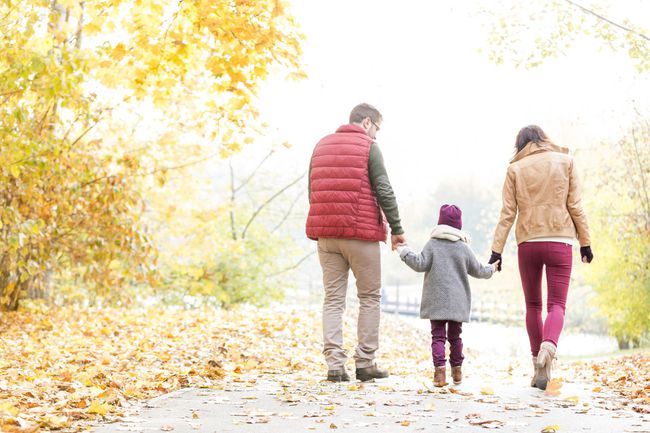Mindfulness is the practice of detaching yourself from the craziness of the outside world and your own racing thoughts by honing in on the calm center that is always inside you. Studies have found that mindfulness reduces anxiety, even in people who haven’t done the practice for very long. Kids and adults who do mindfulness activities actually learn better. And if your child has ADHD, these techniques may help reign in impulsiveness and hyperactivity.
Mindfulness has so many benefits that it’s even increasingly being taught in schools. But even better, it’s something you, as a parent, can do with your own family. The following family-friendly mindfulness activities are both fun and powerful. Try one (or all!) of them with your family the next time you need some calm in your lives.

1. Take a listening walk.
Go someplace—even your backyard—and walk together in silence, listening for sounds you typically overlook: leaves rustling, a pine cone falling from a tree, your own steady breath. To enhance the quietest sounds (and make it more fun), you can turn paper cups into amplifiers by cutting a hole in the sides of two cups and hooking them over your ears, drinking side facing forward. Although nature is especially relaxing, a listening walk can occur anywhere—even a noisy shopping mall or restaurant.
2. Really taste what you're eating.
With the taste, textures, and temperature of foods so different, mindful eating is one of the easiest practices. Ask everyone to spend the first few minutes of certain meals silently playing with the food in their mouth, noticing the varied sensations of, say, a spoonful of hot oatmeal topped with fruit, nuts, and cinnamon, or a warm juicy burger and cold mushy bun—with that burst of sweet, liquidy ketchup. Your mind will inevitably run away at some point (to whether bath time will be late today or you forgot to call the dentist…). When you realize you’ve stopped focusing, simply bring it back.
3. Go inside your body.
Mindfulness pioneer Jon Kabat-Zinn from the University of Massachusetts encourages people to do a “body scan.” Sit or lie with your kids and, starting with the toes, silently or out loud bring awareness to one body part for a moment, until you’ve worked your way up to the top of your head. A variation is for everyone to take turns naming one part of their body out loud and briefly describing how that part feels. You might start by saying, “I’m focused on my stomach, and it feels rumbly.” Your child then continues, “I’m focused on my left toes, and they feel tingly.” Continue for as long as there’s interest, or just do one round periodically through the day. This mindfulness activity for kids can also serve as an anatomy lesson!
4. Savor some silence.
During a period of enforced quiet, everyone goes through their regular routines—but they don't speak. Start with 5 or 10 minutes and try to work up to an hour or more. (A family I know observes silent Saturdays from wake-up until noon.) Other types of communication—writing, signaling, sign language—should be discouraged, although you can give everyone a small note pad to jot down thoughts, to be passed around later. The first time I observed silence, I was shocked—not by the quiet, but by the noise. My mind rushed to fill the stillness with jabbering inside my head. After a while though, the mental noise lessens (but never stops entirely). You will notice that the world is more vibrant than before, because when you shut down the avenue where so much energy escapes, it is rechanneled to the other senses.
5. Try a sitting meditation.
A formal meditation, where you sit without moving and focus on a single thing, can be difficult for kids (and adults!). But it is very effective—which is why Buddhist monks, Hindu swamis, and Christian contemplative practitioners spend so much time at it. Turn down the lights and your phones off and have everyone sit on the floor (or a chair with a back) for a few minutes. The most common form of meditation is to focus on the breath. Kids can get the hang of this by envisioning they are slowly blowing out to cool a cup of hot tea, then slowly breathing in to sip the cooler tea. (Eventually, work up to breathing in and out through the nose.) End each session with a moment that solidifies the sacredness before everyone makes their mad scramble. In our home, we stand in a circle and hold hands, “squeezing” a bit of love into the hand of the person to the right, until the love goes around a few times.
6. Use the Stop, Breathe & Think Kids app.
Playing video games or screening Netflix is the opposite of mindfulness, but that doesn’t mean you should ignore your phone entirely. Some apps—such as Stop, Breathe & Think Kids—focus on mindfulness activities for kids. The app encourages users to check in with their emotions through emojis, and it also has a series of “mindful missions” that increase focus while calming the mind. These activities also promote better sleep, decrease stress, and manage over-excitement. Users get awarded for completing the missions, and they can close the app feeling better all around.
Meryl Davids Landau is the author of the new book Enlightened Parenting: A Mom Reflects on Living Spiritually With Kids.
